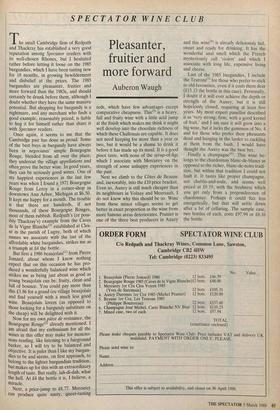SPECTATOR WINE CLUB
Pleasanter, fruitier and more forward
Auberon Waugh
The small Cambridge firm of Redpath and Thackray has established a very good reputation among Spectator readers with its well-chosen Rhones, but I hesitated rather before letting it loose on the 1985 burgundies, which I have been tasting now for 18 months, in growing bewilderment and disbelief at the prices. The 1985 burgundies are pleasanter, fruitier and more forward than the 1983s, and should certainly be drunk before them, although I doubt whether they have the same massive potential. But shopping for burgundy is a nightmare, and any merchant who finds a good example, reasonably priced, is liable to hog it for himself rather than share it with Spectator readers.
Once again, it seems to me that the Cambridge pair has done us proud. Some of the best buys in burgundy have always been in negociants' simple Bourgogne Rouge, blended from all over the place; they undercut the village appellations and often.prove the better wine. In good years, they can be seriously good wines. One of my happiest experiences in the last few years was when I found a.,1971 Bourgogne Rouge from Leroy in a corner-shop in downtown Ann Arbor, Michigan at $6.50. It kept me happy for a month. The trouble is that there are hundreds, if not thousands, of these Bourgogne Rouges, most of them rubbish. Redpath's (or poss- ibly Thackray's) example from the Caves de la Vigne Blanche) established at Cles- se in the parish of Lugny, both of which names we associate with the last of the affordable white burgundies, strikes me as a triumph at £4 the bottle. But first a 1986 beaujolais(1) from Pierre Jomard, about whom I know nothing expect that on this occasion he has pro- duced a wonderfully balanced wine which strikes me as being just about as good as young beaujolais can be: fruity, clean and full of bounce. You could pay more than this £3.86 for a grand cm village beaujolais and find yourself with a much less good wine. Beaujolais lovers (as opposed to those looking for a burgundy substitute on the cheap) will be delighted with it. Now for my ownyiece de resistance, the Bourgogne Rouge(`) already mentioned. I am afraid that my enthusiasm for all the wines in this offer may make for monoto- nous reading, like listening to a fairground barker, so I will try to be balanced and objective. It is paler than I like my burgun- dies to be and seems, on first approach, to belong to the lighter burgundian tradition, but makes up for this with an extraordinary length of taste. But really, lah-di-dah, what the hell. At £4 the bottle it is, I believe, a miracle.
Next, a price-jump to £8.77. Mercurey can produce quite nasty, queer-tasting reds, which have few advantages except comparative cheapness. This(3) is a heavy, full and fruity wine with a little acid jump at the finish which makes me think it might well develop into the chocolate richness of which these Challonais are capable. It does not need keeping for more than a year or two, but it would be a shame to drink it before it has made up its mind. It is a good pinot taste, with none of the syrup-of-figs which I associate with Mercurey on the strength of some unhappy experiences in the past.
Next we climb to the Cotes de Beaune and, inexorably, into the £10 price bracket. Even so, Auxey is still much cheaper than its neighbours in Volnay and Meursault. I do not know why this should be so. Wine from these minor villages seems to get better in exact proportion as the wine from more famous areas deteriorates. Prunier is one of the three best producers in Auxey and this wine) is already deliciously full, sweet and ready for drinking. It has the wonderful anal smell which the French mysteriously call 'violets' and which I associate with long life, expensive living and cheese.
Last of the 1985 burgundies, I include the Teurons(5) for those who prefer to stick to old favourites, even if it costs them dear (£13.13 the bottle in this case). Personally, I doubt if it will ever achieve the depth or strength of the Auxey, but it is still hopelessly closed, requiring at least five years. My most expert panellist described it as 'very strong; firm, with a good kernel of fruit,' and I am sure it will grow into a big wine, but it lacks the gaminess of No. 4 and for those who prefer their pheasants dead and hanging in the larder to cackling at them from the bush, I would have thought the Auxey was the best bet. Finally a champagne(6). This wine be- longs to the chardonnay blanc-de-blancs as opposed to the richer, blanc-de-noirs tradi- tion, but within that tradition I could not fault it. It tastes like proper champagne, not chablis-and-soda, and seems well priced at £9.19, with the freshness which you get only from a preponderence of chardonnay. Perhaps it could fizz less energetically, but that will settle down after a bit of cellaring. The sample case, two bottles of each, costs £97.94 or £8.16 the bottle.


















































 Previous page
Previous page